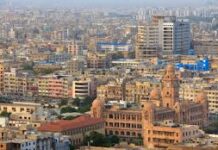By Muhammad Luqman
The US dollar hit a record high of Rs 121 against Pakistani rupee in interbank trading Monday, after country’s central bank devalued the currency for the third time since December.
The greenback, which was previously standing at Rs 115.63, rose by Rs 5.38 according to media reports.
Dollar’s upward journey comes amid mounting economic pressure and speculation that the country may need International Monetary Fund support which the interim government has denied last week. Meanwhile, increasing imports and a widening current account deficit are being cited as the major reasons.
Earlier in March this year, the US dollar had shot up by Rs4.93 in the interbank market to hit a high of Rs 115.50 before coming down to Rs 115 at the close of business.
The State Bank of Pakistan’s (SBP) decision to introduce identification requirements for all foreign currency buy and sell transactions equivalent to $500 or above on exchange companies and directed them to retain the copies of identification documents to comply with anti-money laundering rules has contributed to a slow down in the flow of dollars to the dealers.
On June 1, the rupee plunged to a then-record low of Rs119.35 in the kerb market against the US dollar on Friday, as dwindling foreign exchange reserves continued to impact the local currency.
A low inflow of dollars from overseas Pakistani’s and dipping forex reserves had increased demand and prices in the kerb market since the commencement of Ramazan.
It would be the third time that Pak Rupee has devalued during the current financial year. Govt. had devalued Pak Rupee by around 5 percent on Dec 8th, 2017 to Rs110 and then again by around 4.5 percent to Rs15 on Mar 20, 2018.
In the last decade, the rupee has devalued annually by around 5 percent.
IMF’s post programme report released in March had welcomed the central bank’s decision of allowing the rupee to depreciate against the dollar in early-December 2017 but emphasized on the significance of greater exchange rate flexibility on a more permanent basis to enhance competitiveness and safeguard external buffers.
The IMF report added “staff advised to unwind the increased government borrowing from the SBP, which would support monetary tightening. Going forward, greater exchange rate flexibility will need to be accompanied by a further adjustment of the policy stance as well as a strengthening of the interest rate-based monetary policy framework with appropriate intermediate and operational monetary policy targets, and a clear limit to FX interventions.”
 In a reaction to the situation on Monday evening, the State Bank of Pakistan (SBP), termed the gap between the demand and supply as the the reason for unprecedented appreciation of US Dollar.
In a reaction to the situation on Monday evening, the State Bank of Pakistan (SBP), termed the gap between the demand and supply as the the reason for unprecedented appreciation of US Dollar.
“The market-based adjustment is reflective of the country’s external Balance of Payments position which is under pressure due to a large trade deficit,” the central bank spokesman said.
Despite the continued growth in exports (13.3 percent in Jul-Apr FY18) and some uptick in remittances, growing imports have pushed the current account deficit to US$ 14.0 billion during the first ten months of FY18.
“SBP will continue to closely monitor the foreign exchange markets; and stands ready to ensure stability in the financial markets and curb the emergence of speculative pressures,” the spokesman said..















